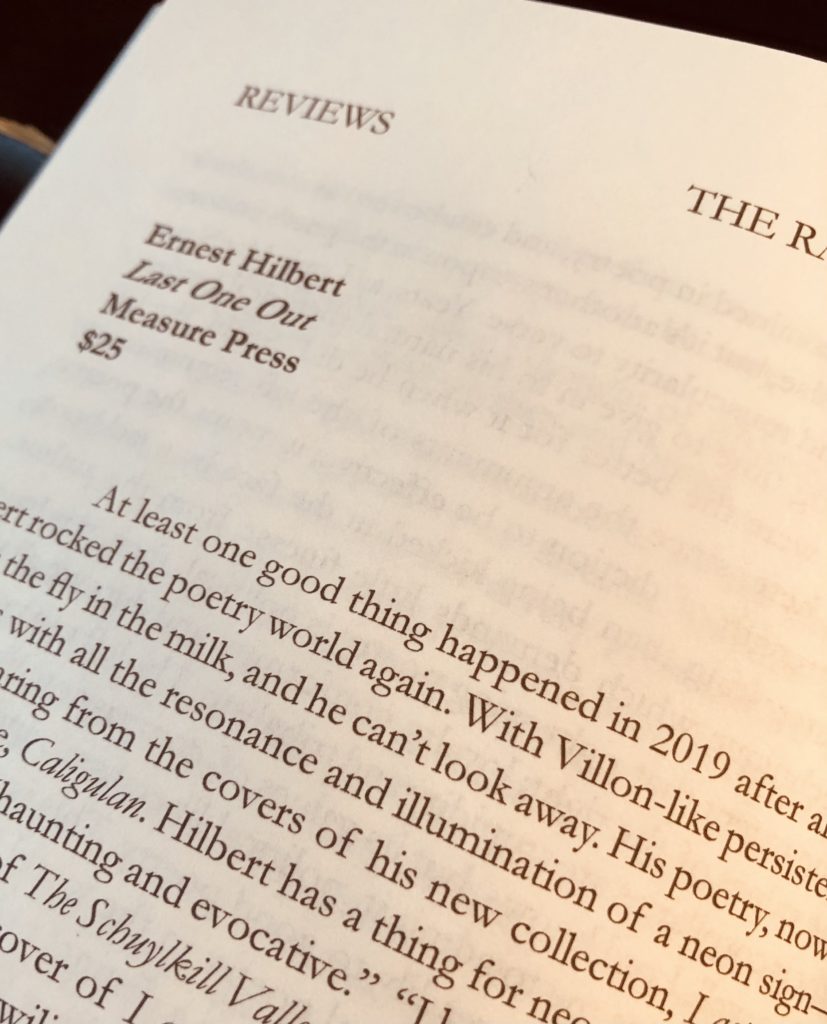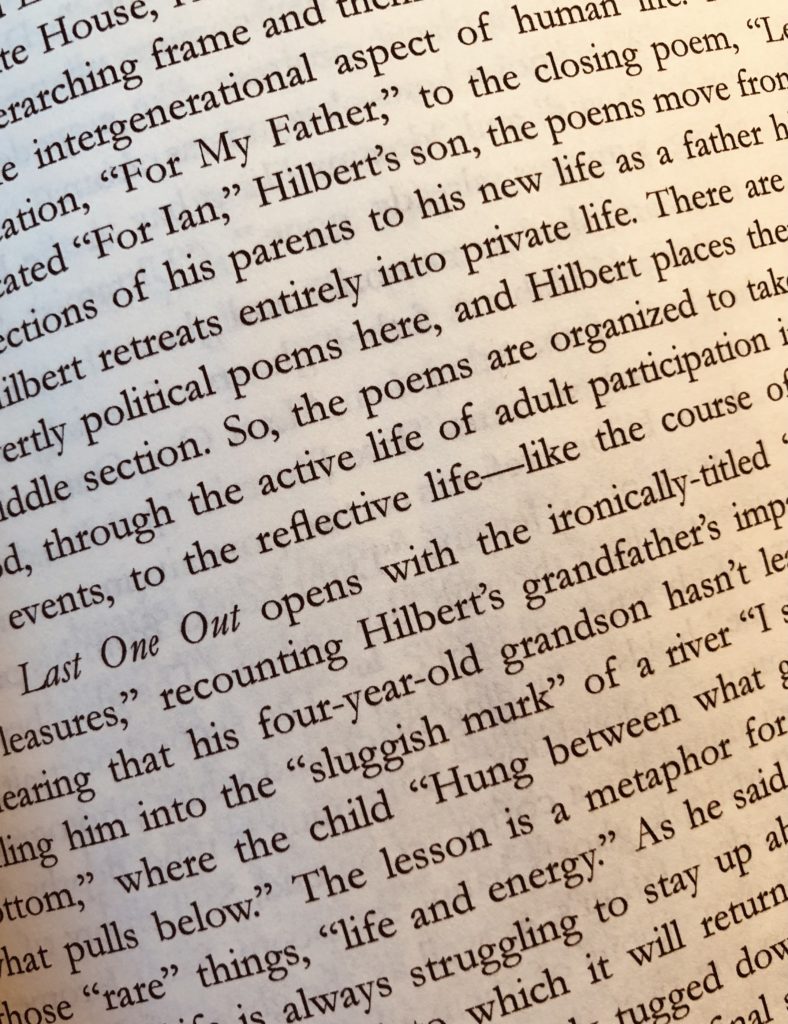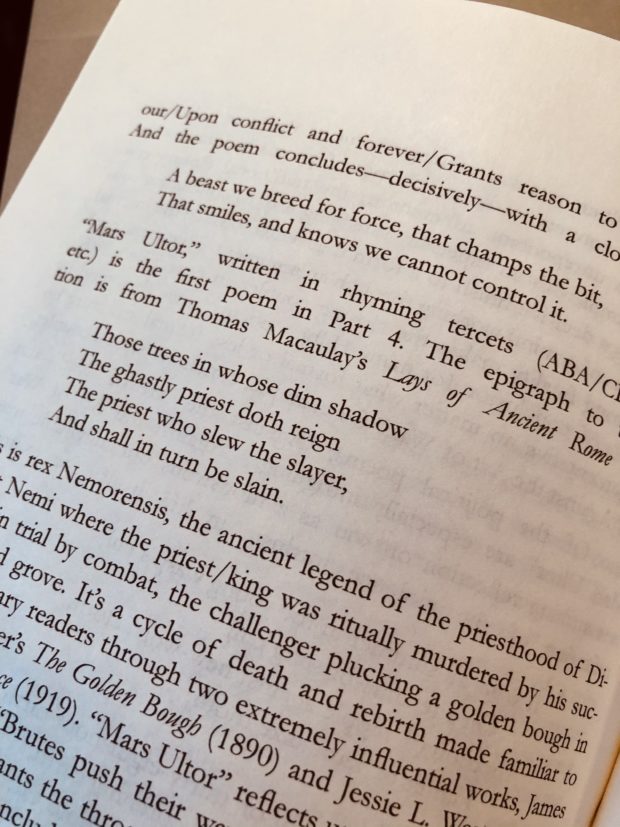Poet and critic Wendy Sloan wrote about Ernest Hilbert’s fourth book, Last One Out, in the Raintown Review, Number 1, New Series, Winter 2021. Click here to submit, subscribe, or to learn more about the journal. With permission of the journal, you may read the full review below, here on E-Verse.
Ernest Hilbert
Last One Out
86 pp. Measure Press
Reviewed by Wendy Sloan
At least one good thing happened in 2019 after all: Ernest Hilbert rocked the poetry world again. With Villon-like persistence, Hilbert sees the fly in the milk, and he can’t look away. His poetry, now as always, strikes with all the resonance and illumination of a neon sign—like the neon blaring from the covers of his new collection, Last One Out, and his last one, Caligulan. Hilbert has a thing for neon. In a 2017 interview he called it “haunting and evocative.” “I love neon.” he told Mark Danowsky, editor of the Schuylkill Valley Journal, “I think it’s a truly American medium.” The cover of Last One Out sports eerie whitish neon lights shining against a twilight landscape. Is it dusk—or could it be dawn?
Hilbert has always stood out as a poet with something to say. Take any poem in his last book, Caligulan, winner of the 2017 Poets’ Prize. That word, “Caligulan,” was invented and defined by Hilbert as evoking the dread, the “[i]logical fear that disaster … might befall one at any time…” In short, it’s the “sense that something is very, very wrong.” So a Hilbertean speaker is left wondering, in “CASH FOR GOLD,” “Why we never talk about money / Until it’s gone. Is it because something’s / Wrong with us? Something’s wrong / With us. I always knew it.” These lines are typical of Hilbert’s dark humor, humor driven by elements of “Caligulan” dread and disassociation from our increasingly plastic, consumption-driven society. Yet in the 2017 Schuylkill interview Hilbert nonetheless emphasized that, in reality, “The world has been ending for a very long time” and the “. . . belief that matters can’t get any worse, or are quickly worsening, and that some cataclysmic reckoning is at hand, is an age-old feeling.” Maybe so. Still, his evocations of the Caligulan mindset sure seem spot on in these times, as our lives are increasingly measured out in serial disasters.
And so in Last One out, now that we have our very own Caligula in the White House, Hilbert has moved on, as he/we must to survive. The overarching frame and theme of this work is a new one for Hilbert: the intergenerational aspect of human life. From the opening dedication, “For My Father,” to the closing poem, “Lesser Feasts,” dedicated “For Ian,” Hilbert’s son, the poems move from Hilbert’s recollections of his parents to his new life as a father himself. Not that Hilbert retreats entirely into private life. There are historical and overtly political poems here, and Hilbert places them in the book’s middle section. So the poemsare organized to take us from childhood, through the active life of adult participation in the wide world’s events, to the reflective life – like the course of a lifetime.
Last One Out opens with the ironically-titled “Welcome to all the Pleasures,” recounting Hilbert’s grandfather’s impatient reaction to hearing that his four-year-old grandson hasn’t learned to swim: hurling him into the “sluggish murk” of a river “I swear … had no bottom,” where the child “Hung between what glows above / And what pulls below.” The lesson is a metaphor for Hilbert’s view of those “rare” things, “life and energy.” As he said in the Schuylkill interview, “Life is always struggling to stay up above the abyss from which it emerges and to which it will return. The flower reaches for the sun … we are constantly tugged downward, and eventually we go down for good.” In the book’s final section, Hilbert holds a son of his own “swaddled in butterflies,” needing to be “cradl[ed] . . . carefully / Like a football in one arm” (“Super Bowl Sunday”).
Hilbert’s work attains a high level of intensity through laser-sharp vision focused unsparingly on the detritus of post-modern life. Maybe that’s because he lives, as he told Schuylkill, “in ruins, to a certain extent” in Philadelphia, “a stabilized ruin” where “a day with a brisk wind will blow trash all over.” Like Hilbert’s earlier books, Last One Out is full of trash. He “dodge(s) down” the city’s streets “Breathing garbage . . .” (“Walnut Street”). Where “[a] bank was . . . Shadow letters remain / Like damp squares of towels peeled from concrete” while “. . . Urine pools in a corner” (“Center City”). Discarded everyday objects take on significance as they conjure up memories. A “tube of old sunscreen” is “a plastic promise, like a spade and pail” that “summons— / Who knows how—hazy vistas, aromas of steak, / Sprinkler-shimmered lawns . . .” and “dreams like a bay in the humid night, / Still promising summers already gone” (“Ultramist Sport TM”).

Shadows and shades, memories and ghosts haunt these ruins, especially the ghost of Hilbert’s father, ghosts of various artists, and, for course, the ghost of the title poem, “Last One Out.” His father’s ghost dominates the early sections. “Two Portraits” posits a dialectic of contrasting shades, as Hilbert reflects on two portraits in a room. In the first, a Durer engraving of St. Jerome, “Light breaks from his pate like a borealis, / Serene as the light through his window. / The glass becomes a pool that swims / With reflected light . . .” The second portrait, in a “cheap rusted frame” holds a “fading black-and-white photograph / Of my father, raising me, a blond boy . . . Dimming in time, depths flattened, / The portrait shines like a coffin set on end, Still empty of its intended occupant.” Multiple ghosts haunt the poem: Saint Jerome’s, Durer’s, Hilbert’s long-dead father’s, as well as the ghost of Hilbert’s childhood self and his own visions of them all. In “Great Bay Estuary,” Hilbert remembers the river where “Four decades ago I plied these waters / With my father…” and “[g]hosts of petrified white cedars [stood] … [i]n the murky hush / Of dusk.” Now, he “lie[s] in bed under cresting waves of wool, / Steering my ivory sloop with sails of ice / In the New Jersey sunset … the pull / Of memory, time-consumed sinking of sights / Once solid . . . led / To my bedside in the last of the light.”
In “Haunts,” Hilbert recreates his Philadelphia neighborhood, where “Iron gates catch a trove of wind-blown foil, / Crushed cupolas of Styrofoam, / Folded sails of wet newspaper.” The garbage-strewn streets are haunted by the artist/cartoonist Charles Addams (1912-1988), whose amusingly macabre characters ultimately became the Addams Family on TV. College Hall, the oldest building on the campus of the University of Pennsylvania, inspired the Addams Family mansion. Hilbert calls upon Addams’ ghost: “Charles Addams, you strolled / These streets, observed the late sun / Burn and bulge in bay windows . . .” “Would you have drawn me,” Hilbert asks, “peering / From behind blinds . . . As sun returns long shadows to our street?”
Even in the quiet of his own “House and Home” at night, Hilbert “wait(s) for a ghost / To present itself in the creaking halls . . . But no ghost, not yet. When I rise at night / For the bathroom, past the empty spare room, / I feel a boy’s fingers, faint as snow, on my wrist.” For, after all, such is the “Memory of a Writer,” who
. . . hear(s) notes from a song, far off somewhere
Though we can only make out its crude contours
And after a while of quietly straining
To hear it, we just let it fade away
Like jet trails across a chilled blue sky,
Blue like a cheap drink on some holiday
We never took, but we know others did,
Must have, while we gathered here in this room
Laddered with shelves, bricked-in with books,
Telling stories about things that may
Have happened, and often did, somewhere else.
This writing is just plain beautiful, and there’s plenty of beautiful use of language in Last One Out, more than in Hilbert’s earlier work. It’s as if he were no longer afraid of it—no longer constrained by Hemingway’s ban on adjectives and poetry workshop bans on adverbs, or antiquated words. He has a pitch-perfect ear, and it’s no surprise, since Hilbert’s also a musician (heavy metal) who writes opera libretti and has recorded his own poetry set to music. There is more full-on, brazen end-rhyme in this book, too, particularly in the poems written in tercets. In the book’s final poem, “Lesser Feasts,” Hilbert adopts his most habitual sonnet rhyme scheme, ABC/ABC, to a poem written in tercets. The effect is to make the end rhyme more pronounced than it seemed in his sonnets. Rhymed couplets also abound, including poems composed in heroic couplets, like “American Glass” and the title poem, “Last One Out.”
Last One Out also marks something of a departure from Hilbert’s previous work in terms of poetic form. Most notably, the book has hardly any sonnets—only three “real” sonnets, by my strict count, “My Father’s Dante,” “Ship’s Bottom, 1972,” and “Amusements.” Each evokes a childhood memory: a father’s book taken up twenty years after his death, “[t]he book that draws me faster on to you,” a photograph that fixes parent and child “forever there,” a memory of a trip to an amusement park and that climactic moment on the roller coaster when “the clinking slows as you reach the top / And panic, knowing you can’t make it stop.” Each anchors the past in the present making clear, to paraphrase Faulkner, that the past is never dead, it’s not even really past, a Faulkner line Hilbert quotes in the Schuylkill interview.
The near-absence of sonnets from Last One Out struck me at first as something of a loss, as Hilbert does the sonnet so well. Still, the dominance of other lyrics extends a trend that began in Caligulan, evincing, I suppose, expansion and development of Hilbert’s style. The work within other structures—poems written in tercets, or couplets, or quatrains, or looser, more original forms that seem to arise organically through the writing process— the drift, metrically, towards a more regular iambic pentameter, and away again, or towards a regular rhyme scheme, and away—all of these elements give the book something of a transitional feel. And maybe that’s how Hilbert wants us to feel: not static, but in flux, involved in a process of change, in the constant flow of life and memory.
Still, Hilbert retains and adopts some of the same techniques he used in his sonnets to the other types of poems in Last One Out. Hilbert is an unrepentant adherent to the traditional closing couplet, for example. It’s an especially satisfying way to conclude a sonnet, making a decisive finish to a form that tends to trace the internal movements of a mind working through an argument. That same quality of strong finality makes the closing couplet an especially satisfying mode of conclusion for many Hilbert poems, since they tend to be argumentative no matter what formal or less formal structure he uses. Against the Art of War, for example, concludes with a couplet.
Of the political poems, “Against the Art of War” and “Mars Ultor” are especially intriguing. “Against the Art of War” is a striking reflection on war as a monstrous but inevitable magnification of the violence intrinsic in life itself, for example:
It waits all summer in the young wasp’s tail,
On a tetanus-brisling nail,
Abrasion of nipple against new-worn cloth,
Flutter of kamikaze moth,
The ache and doubt of thirty-eight-hour birth,
The glare of sunlight scorching earth,
The crouch and pounce of household cat,
The loser’s shoulders pinned to mat,
The slippery floor of the slaughterhouse,
A trap pulled back for a mouse;
It’s there in landslide and lightning storm,
And viral phlegm’s infectious swarm.
“Is life not filled enough with things like war?” Hilbert asks, “The prodigal genius of human kind / Confers renewed glamour / Upon conflict and forever/Grants reason to summon it . . .” And the poem concludes—decisively—with a closing couplet:
A beast we breed for force, that champs the bit,
That smiles, and knows we cannot control it.
“Mars Ultor,” written in rhyming tercets (ABA/CDC/EFE, etc.) is the first poem in Part 4. The epigraph to the section is from Thomas Macaulay’s Lays of Ancient Rome (1842):
Those trees in whose dim shadow
The ghastly priest doth reign
The priest who slew the slayer,
And shall in turn be slain
This is Rex Nemorensis, the ancient legend of the priesthood of Diana at Nemi where the priest-king was ritually murdered by his successor in trial by combat, the challenger plucking a golden bough in the sacred grove. It’s a cycle of death and rebirth made familiar to contemporary readers through two extremely influential works, James George Frazer’s The Golden Bough (1890) and Jessie L. Weston’s From Ritual to Romance (1919). “Mars Ultor” reflects upon this cyclical struggle for power: “Brutes push their way to power, / But the muddiest barbarian / Also wants the throne an hour” and, strengthening the allusion to Frazer, concludes: “And dons a crown, marks affairs, / Nods under a golden branch until / A stronger one turns up the stairs.”

Hilbert pays close attention to the structure and appearance of his books—his day job is as an antiquarian book dealer. Highly conscious of the book as object, he has devoted a lot of time and attention to the organization, format and cover of Last One Out, and so should we. The title of the bookis also the title ofthe last poem in Part 3, consisting in its entirety of three stanzas of heroic couplets:
Some lied to get away from their own friends
And he always said that so much of it depends . . .
One day the last host will slam the last door
The last smoked ash will settle on the floor,
And he’ll look up, and stop, maybe toast
Himself, with the slow, confused motions of a ghost.
As a title for the book as well as the poem, Last One Out necessarily becomes a metaphor for the whole work, assuming both the book’s theme of generational movement from childhood to parenthood and the writer’s bid for immortality and, in so doing, giving a nod toward the possibility of transcendence. Does the cover also hint at that possibility? Red neon lights line a path through the gloom, leading towards, but not clearly to, the horizon and infinity beyond. After all, who will be the last one out? Non Omnis Moriar, “I shall not wholly die,” Hilbert declares in the front piece to the book, his translation of Horace’s Carmina 3/30:6. The epigraph works on the same two levels, emphasizing, first, the poet/parent’s continuation of life through his newborn son, and second, the artist’s bid for immortality through the poetry he hopes will survive him and endure. It reminds me of a story about the Buddha. To paraphrase: A student asked the Buddha, “Master, what’s the most I can expect from life?” The Buddha replied “First your parents will die, then you will die, then your children will die.”Or, in Hilbert’s closing words to the book in “Lesser Feasts”:
The hard world yields little we may possess.
Our newborn opens and fastens his fist.
Happy, we sort a small steading for our son.
Year’s end, and light’s begun to dispossess
The exhausted dark. I trace his small wrist.
May life, like light, be strong before it’s done.
Wendy Sloan practiced labor and civil rights law with the firm of Hall & Sloan before returning to poetry. Her collection is Sunday Mornings at the Caffe Mediterraneum (Kelsay Books, 2016). Sloan’s poems and Italian translations have appeared in many journals including Big City Lit, Blue Unicorn, Light, Measure, Mezzo Cammin, The Orchard, Think, and Umbrella, and in the anthologies The Able Muse Translation Issue, The Best of the Raintown Review, Extreme Sonnets, The Great American Wise-Ass Poetry Anthology, Love Affairs at the Villa Nelle, and Poems for a Liminal Age, benefiting Medecins Sans Frontieres, U.K. She has been a finalist in the Howard Nemerov Sonnet Award Competition, and several of her poems have been nominated for a Pushcart Prize. Sloan lives in New York City, where she co-hosts the Carmine Street Metrics poetry reading series.



No Comments